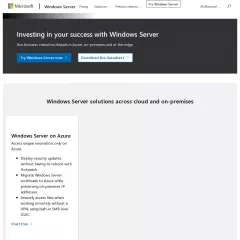Windows Server 
Windows Server is used by 6.08% of sites
Official Website
http://microsoft.com/windowsserverCategory
Operating Systems
Windows Server is a server operating system developed by Microsoft as part of the Windows NT family of operating systems. It is designed to provide a reliable, secure, and scalable platform for running server applications and managing network services.
Key features and characteristics of Windows Server include:
Server Roles and Services: Windows Server offers a wide range of server roles and services that enable it to fulfill different server functionalities. These include Active Directory Domain Services (AD DS), DNS server, DHCP server, file and storage services, web server (IIS), print server, database server, virtualization, and many more.
Active Directory Domain Services (AD DS): AD DS is a directory service that stores information about network resources, such as user accounts, groups, computers, and organizational units. It provides centralized authentication and authorization services and facilitates the management of user and computer accounts in a network environment.
Scalability and Performance: Windows Server is designed to scale from small businesses to large enterprise environments. It supports multi-core processors, large memory configurations, and clustering technologies to enhance performance and handle high workloads.
Security Features: Windows Server incorporates various security features to protect server resources and data. It includes built-in firewall capabilities, secure remote access, user account control, Group Policy, encryption technologies, and support for security standards and protocols.
Management Tools: Windows Server provides a range of management tools that simplify server administration and configuration. This includes the graphical user interface (GUI) through the Windows Server Desktop Experience, as well as command-line tools and PowerShell for advanced scripting and automation.
Virtualization: Windows Server includes Hyper-V, Microsoft's virtualization platform, which allows you to create and manage virtual machines (VMs) on a server. Hyper-V enables server consolidation, efficient resource utilization, and provides a platform for building virtualized environments.
Cloud Integration: Windows Server seamlessly integrates with Microsoft's cloud services, such as Azure, allowing hybrid cloud scenarios and providing features like backup, disaster recovery, and storage solutions through Azure integration.
Remote Desktop Services: Windows Server includes Remote Desktop Services (RDS) that allow users to access virtual desktops and remote applications over a network. RDS enables centralized desktop and application deployment, remote management, and secure remote access.
Containers: Windows Server supports containerization through technologies like Docker and Windows Server Containers. Containers provide lightweight, isolated environments for deploying and running applications, allowing for efficient resource utilization and easy application deployment.
Support and Updates: Windows Server receives regular updates and patches from Microsoft to address security vulnerabilities, improve performance, and introduce new features. Microsoft offers different editions of Windows Server, each with varying levels of features and support options.
Windows Server is widely used in enterprise environments for hosting critical server applications, managing network services, and providing centralized administration. Its integration with Microsoft's ecosystem and comprehensive feature set make it a powerful platform for businesses of all sizes.
Key features and characteristics of Windows Server include:
Server Roles and Services: Windows Server offers a wide range of server roles and services that enable it to fulfill different server functionalities. These include Active Directory Domain Services (AD DS), DNS server, DHCP server, file and storage services, web server (IIS), print server, database server, virtualization, and many more.
Active Directory Domain Services (AD DS): AD DS is a directory service that stores information about network resources, such as user accounts, groups, computers, and organizational units. It provides centralized authentication and authorization services and facilitates the management of user and computer accounts in a network environment.
Scalability and Performance: Windows Server is designed to scale from small businesses to large enterprise environments. It supports multi-core processors, large memory configurations, and clustering technologies to enhance performance and handle high workloads.
Security Features: Windows Server incorporates various security features to protect server resources and data. It includes built-in firewall capabilities, secure remote access, user account control, Group Policy, encryption technologies, and support for security standards and protocols.
Management Tools: Windows Server provides a range of management tools that simplify server administration and configuration. This includes the graphical user interface (GUI) through the Windows Server Desktop Experience, as well as command-line tools and PowerShell for advanced scripting and automation.
Virtualization: Windows Server includes Hyper-V, Microsoft's virtualization platform, which allows you to create and manage virtual machines (VMs) on a server. Hyper-V enables server consolidation, efficient resource utilization, and provides a platform for building virtualized environments.
Cloud Integration: Windows Server seamlessly integrates with Microsoft's cloud services, such as Azure, allowing hybrid cloud scenarios and providing features like backup, disaster recovery, and storage solutions through Azure integration.
Remote Desktop Services: Windows Server includes Remote Desktop Services (RDS) that allow users to access virtual desktops and remote applications over a network. RDS enables centralized desktop and application deployment, remote management, and secure remote access.
Containers: Windows Server supports containerization through technologies like Docker and Windows Server Containers. Containers provide lightweight, isolated environments for deploying and running applications, allowing for efficient resource utilization and easy application deployment.
Support and Updates: Windows Server receives regular updates and patches from Microsoft to address security vulnerabilities, improve performance, and introduce new features. Microsoft offers different editions of Windows Server, each with varying levels of features and support options.
Windows Server is widely used in enterprise environments for hosting critical server applications, managing network services, and providing centralized administration. Its integration with Microsoft's ecosystem and comprehensive feature set make it a powerful platform for businesses of all sizes.